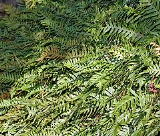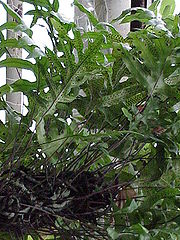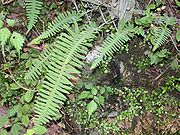
Polypodium
Encyclopedia
Polypodium is a genus
of 75–100 species
of true fern
s, widely distributed throughout the world, with the highest species diversity in the tropics
. The name is derived from Ancient Greek
poly (πολύ) "many" + podion (πόδιον) "little foot", on account of the foot-like appearance of the rhizome
and its branches. They are commonly called polypodies or rockcap ferns, but for many species unique vernacular names exist.
They are terrestrial
or epiphytic
ferns, with a creeping, densely hairy or scaly rhizome
bearing frond
s at intervals along its length. The species differ in size and general appearance and in the character of the fronds, which are evergreen, persisting for 1-2 years, pinnate or pinnatifid (rarely simple entire), and from 10-80 cm or more long. The sori
or groups of spore-cases (sporangia) are borne on the back of the frond; they are globose and naked, not covered with a membrane (indusium).
Polypodies have some use in herbalism
, but are today most important in horticulture
where several species, hybrids, and their cultivar
s like Polypodium 'Green Wave' are commonly used as ornamental plant
s for shady locations. Polypodium have a bitter-sweet taste and are among the rather few ferns that are used in cooking
; in this case as a spice e.g. for nougat
.




A number of species formerly included in the genus have recently been transferred to other genera, including Campyloneurum
, Cyathea
, Drynaria
, Microgramma, Nephrolepis
, Neurodium, Pecluma
, Phlebodium
, and Pleopeltis
.
Genus
In biology, a genus is a low-level taxonomic rank used in the biological classification of living and fossil organisms, which is an example of definition by genus and differentia...
of 75–100 species
Species
In biology, a species is one of the basic units of biological classification and a taxonomic rank. A species is often defined as a group of organisms capable of interbreeding and producing fertile offspring. While in many cases this definition is adequate, more precise or differing measures are...
of true fern
Fern
A fern is any one of a group of about 12,000 species of plants belonging to the botanical group known as Pteridophyta. Unlike mosses, they have xylem and phloem . They have stems, leaves, and roots like other vascular plants...
s, widely distributed throughout the world, with the highest species diversity in the tropics
Tropics
The tropics is a region of the Earth surrounding the Equator. It is limited in latitude by the Tropic of Cancer in the northern hemisphere at approximately N and the Tropic of Capricorn in the southern hemisphere at S; these latitudes correspond to the axial tilt of the Earth...
. The name is derived from Ancient Greek
Ancient Greek
Ancient Greek is the stage of the Greek language in the periods spanning the times c. 9th–6th centuries BC, , c. 5th–4th centuries BC , and the c. 3rd century BC – 6th century AD of ancient Greece and the ancient world; being predated in the 2nd millennium BC by Mycenaean Greek...
poly (πολύ) "many" + podion (πόδιον) "little foot", on account of the foot-like appearance of the rhizome
Rhizome
In botany and dendrology, a rhizome is a characteristically horizontal stem of a plant that is usually found underground, often sending out roots and shoots from its nodes...
and its branches. They are commonly called polypodies or rockcap ferns, but for many species unique vernacular names exist.
They are terrestrial
Terrestrial plant
A terrestrial plant is one that grows on land. Other types of plants are aquatic , epiphytic , lithophytes and aerial ....
or epiphytic
Epiphyte
An epiphyte is a plant that grows upon another plant non-parasitically or sometimes upon some other object , derives its moisture and nutrients from the air and rain and sometimes from debris accumulating around it, and is found in the temperate zone and in the...
ferns, with a creeping, densely hairy or scaly rhizome
Rhizome
In botany and dendrology, a rhizome is a characteristically horizontal stem of a plant that is usually found underground, often sending out roots and shoots from its nodes...
bearing frond
Frond
The term frond refers to a large, divided leaf. In both common usage and botanical nomenclature, the leaves of ferns are referred to as fronds and some botanists restrict the term to this group...
s at intervals along its length. The species differ in size and general appearance and in the character of the fronds, which are evergreen, persisting for 1-2 years, pinnate or pinnatifid (rarely simple entire), and from 10-80 cm or more long. The sori
Sorus
A sorus is a cluster of sporangia .In fungi and lichens, the sorus is surrounded by an external layer. In some red algae it may take the form of a depression into the thallus....
or groups of spore-cases (sporangia) are borne on the back of the frond; they are globose and naked, not covered with a membrane (indusium).
Polypodies have some use in herbalism
Herbalism
Herbalism is a traditional medicinal or folk medicine practice based on the use of plants and plant extracts. Herbalism is also known as botanical medicine, medical herbalism, herbal medicine, herbology, herblore, and phytotherapy...
, but are today most important in horticulture
Horticulture
Horticulture is the industry and science of plant cultivation including the process of preparing soil for the planting of seeds, tubers, or cuttings. Horticulturists work and conduct research in the disciplines of plant propagation and cultivation, crop production, plant breeding and genetic...
where several species, hybrids, and their cultivar
Cultivar
A cultivar'Cultivar has two meanings as explained under Formal definition. When used in reference to a taxon, the word does not apply to an individual plant but to all those plants sharing the unique characteristics that define the cultivar. is a plant or group of plants selected for desirable...
s like Polypodium 'Green Wave' are commonly used as ornamental plant
Ornamental plant
Ornamental plants are plants that are grown for decorative purposes in gardens and landscape design projects, as house plants, for cut flowers and specimen display...
s for shady locations. Polypodium have a bitter-sweet taste and are among the rather few ferns that are used in cooking
Cooking
Cooking is the process of preparing food by use of heat. Cooking techniques and ingredients vary widely across the world, reflecting unique environmental, economic, and cultural traditions. Cooks themselves also vary widely in skill and training...
; in this case as a spice e.g. for nougat
Nougat
Nougat is a variety of similar traditional confectioneries made with sugar and/or honey, roasted nuts , and sometimes chopped candied fruit. The consistency of nougat can range from soft and chewy to hard and crunchy depending on its composition, and it is used in a variety of candy bars and...
.
Selected species
Several of the species form hybrids with other species in the genus; these may often be distinguished by being sterile, with very small "blind" sori.



- Polypodium abitaguaePolypodium abitaguaePolypodium abitaguae is a species of fern in the Polypodiaceae family. It is endemic to Ecuador. Its natural habitat is subtropical or tropical moist lowland forests. It is threatened by habitat loss.-Source:...
- Polypodium alfredii
- Polypodium amorphum Suksdorf – irregular polypody
- Polypodium appalachianumPolypodium appalachianumPolypodium appalachianum is a recently-recognized fern species, native to eastern North America. Sometimes called the Appalachian rockcap fern, it is very similar in appearance to Polypodium virginianum. For years, P...
Haufler & Windham – Appalachian rockcap fern - Polypodium argyrolepisPolypodium argyrolepisPolypodium argyrolepis is a species of fern in the Polypodiaceae family. It is endemic to Ecuador. Its natural habitat is subtropical or tropical moist montanes. It is threatened by habitat loss.-Source:...
- Polypodium asterolepis Baker
- Polypodium billardieri
- Polypodium californicumPolypodium californicumPolypodium californicum is a species of fern known by the common name California polypody. It is native to Baja California and California, where it grows along the coastline as well as in moist spots in coastal foothills and mountain ranges in the southern part of its distribution. This polypody...
Kaulf. - Polypodium calirhizaPolypodium calirhizaPolypodium calirhiza is a species of fern in the polypody family. Its common names include Nested polypody and Habit polypody. It is found in California, Oregon, and Mexico. The leaflets on each leaf are broad and oval-shaped, coming to a dull point...
– nested polypody, habit polypody - Polypodium cambricum L. (= P. australe Fée) – southern polypody
- Polypodium chionolepisPolypodium chionolepisPolypodium chionolepis is a species of fern in the Polypodiaceae family. It is endemic to Ecuador. Its natural habitat is subtropical or tropical moist montanes. It is threatened by habitat loss.-Source:...
- Polypodium decumanum – Calaguala fern
- Polypodium excavatum Roxb.
- Polypodium exiguum – hug-me-tight
- Polypodium feei (Bory) Mett.
- Polypodium × font-queri (P. cambricum × P. vulgare)
- Polypodium formosanum Baker - grub fern
- Polypodium furfuraceum Schltdl. & Cham.
- Polypodium glycyrrhiza D.C.Eaton – licorice fern
- Polypodium hesperiumPolypodium hesperiumPolypodium hesperium is a species of fern known by the common name western polypody. It is native to western North America from British Columbia to California, and the Rocky Mountains to northern Mexico, where it grows in rocky habitat types....
Maxon – western polypody - Polypodium incanum
- Polypodium × incognitum
- Polypodium interjectum Shivas – intermediate polypody
- Polypodium latissimumPolypodium latissimumPolypodium latissimum is a species of fern in the Polypodiaceae family. It is endemic to Ecuador. Its natural habitat is subtropical or tropical moist lowland forests. It is threatened by habitat loss.-Source:...
- Polypodium lepidopteris (Langsd. & Fisch.) Kunze
- Polypodium macaronesicum Bobrov
- Polypodium × mantoniae (P. interjectum × P. vulgare)
- Polypodium mindensePolypodium mindensePolypodium mindense is a species of fern in the Polypodiaceae family. It is endemic to Ecuador. Its natural habitat is subtropical or tropical moist montanes.-References:* Navarrete, H. & Pitman, N. 2003. . Downloaded on 23 August 2007....
- Polypodium mixtumPolypodium mixtumPolypodium mixtum is a species of fern in the Polypodiaceae family. It is endemic to Ecuador. It is threatened by habitat loss.-Source:* Navarrete, H. & Pitman, N. 2003. . Downloaded on 23 August 2007....
- Polypodium nigrescens Blume
- Polypodium nipponicum – aonekazura' (Japanese)
- Polypodium percussum
- Polypodium phymatodes L.
- Polypodium piligerumPolypodium piligerumPolypodium piligerum is a species of fern in the Polypodiaceae family. It is endemic to Ecuador. Its natural habitat is subtropical or tropical moist montanes. It is threatened by habitat loss.-Source:...
- Polypodium punctatumPolypodium punctatumPolypodium punctatum is a species of fern in the Polypodiaceae family.- References :* *...
Thunb. ex Murray - Polypodium pustulatumPolypodium pustulatumPolypodium pustulatum is a species of fern in the Polypodiaceae family, native to New Zealand.- References :* Polypodium pustulatum G.Forst., Fl. Ins. Austr. 81 ....
- Polypodium pycnocarpum C.Chr.
- Polypodium quitensePolypodium quitensePolypodium quitense is a species of fern in the Polypodiaceae family. It is endemic to Ecuador. Its natural habitat is subtropical or tropical moist lowland forests. It is threatened by habitat loss.-Source:...
- Polypodium rimbachiiPolypodium rimbachiiPolypodium rimbachii is a species of fern in the Polypodiaceae family. It is endemic to Ecuador. Its natural habitat is subtropical or tropical moist montanes. It is threatened by habitat loss.-Source:...
- Polypodium × rothmaleri (P. cambricum × P. interjectum)
- Polypodium saximontanum Windham
- Polypodium scouleriPolypodium scouleriPolypodium scouleri is a species of fern known by the common names leathery polypody, Scouler's polypody, coast polypody and leather-leaf fern. It is native to coastal western North America from British Columbia to Guadalupe Island off Baja California...
Hooker & Greville – coast polypody - Polypodium scutulatumPolypodium scutulatumPolypodium scutulatum is a species of fern in the Polypodiaceae family. It is endemic to Ecuador. It is threatened by habitat loss.-Source:* Navarrete, H. & Pitman, N. 2003. . Downloaded on 23 August 2007....
- Polypodium segregatumPolypodium segregatumPolypodium segregatum is a species of fern in the Polypodiaceae family. It is endemic to Ecuador. Its natural habitat is subtropical or tropical moist montanes.-References:* Navarrete, H. & Pitman, N. 2003. . Downloaded on 23 August 2007....
- Polypodium sibiricum Sipliv. – Siberian polypody
- Polypodium triseriale Swartz
- Polypodium virginianumPolypodium virginianumPolypodium virginianum, commonly known as Rock Polypody, Rock Cap Fern, or Common Polypody, is a small evergreen species of fern native to the Eastern United States and Canada...
L. – rock polypody - Polypodium vulgarePolypodium vulgarePolypodium vulgare, the common polypody, is a fern of the Polypodiaceae family.- Description :Polypodium vulgare, the common polypody, is a fern developing in isolation from along a horizontal rhizome. The fronds with triangular leaflets measure 10 to 50 centimetres...
– common polypody - Polypodium xalapensePolypodium xalapensePolypodium xalapense is a species of fern in the Polypodiaceae family. It is apparently found only within Central America, especially in Southern Mexico and Guatemala.- References :...
A number of species formerly included in the genus have recently been transferred to other genera, including Campyloneurum
Campyloneurum
Campyloneurum is a genus of ferns in family Polypodiaceae. They are commonly known as strap ferns.-Species:*Campyloneurum abruptum B.Léon*Campyloneurum aglaolepis Sota...
, Cyathea
Cyathea
Cyathea is a genus of tree ferns, the type genus of the fern order Cyatheales. They are mostly terrestrial ferns, usually with a single tall stem. Rarely, the trunk may be branched or creeping. Many species also develop a fibrous mass of roots at the base of the trunk. The genus has a pantropical...
, Drynaria
Drynaria
Drynaria, commonly known as basket ferns, is a genus of ferns in the family Polypodiaceae. It contains around 16 species and one natural hybrid....
, Microgramma, Nephrolepis
Nephrolepis
Nephrolepis is a genus of about 30 species of ferns in the family Nephrolepidaceae or Lomariopsidaceae .-Selected species:* Nephrolepis biserrata Schott. Nephrolepis is a genus of about 30 species of ferns in the family Nephrolepidaceae or Lomariopsidaceae (included in Davalliaceae in some...
, Neurodium, Pecluma
Pecluma
Pecluma is a genus of fern in family Polypodiaceae. It contains the following species :* Pecluma pastazensis, R.C.Moran...
, Phlebodium
Phlebodium
Phlebodium is a small genus of two to four species of ferns, native to tropical and subtropical regions of the Americas. The genus is closely related to Polypodium, and the species were formerly included in that genus....
, and Pleopeltis
Pleopeltis
Pleopeltis is a genus of between 20–50 species of ferns, widely distributed in tropical regions of the world, and also north into temperate regions in eastern North America and eastern Asia....
.

